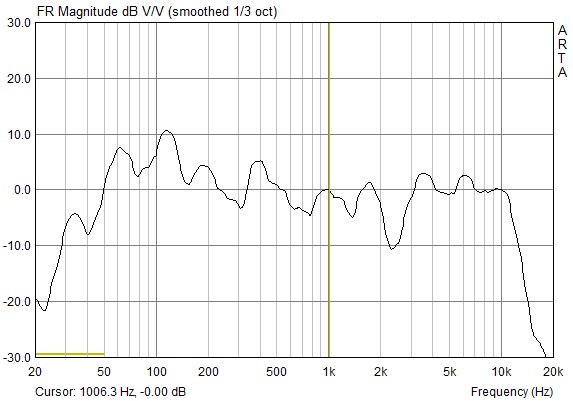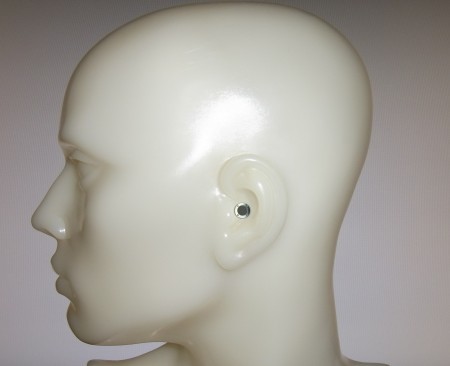Six Peripherals From Tt eSports, Tested And Reviewed
Tt eSports Dracco Captain: Sound Check
Great Lows, But That's About It
The Dracco Captain’s bass is most definitely present and accounted for. Massive explosions in games and movies can be enjoyed in all of their glory. For those with a preference for more balanced response in music, or even cyber-snipers who need to know precisely where their enemies are coming from, I’d only give it a three or four out of 10. The highs start to wane severely at around 11 kHz. Coupled with a big dip at 2.3 kHz, you just don't get a comprehensive acoustic perception of the virtual space.
On the plus side, the insufficient highs can be compensated for with an equalizer. Decreasing the frequencies around 125 Hz, increasing them a bit around 2 kHz, and increasing them around 16 kHz yields an acceptable overall performance that everybody should be able to live with. I believe that the fault here lies with the ear padding; a more balanced frequency curve could probably be obtained if their shape and thickness were optimized. The amount of pressure on the ear cups also influences the headphone’s sound characteristics. It’s important to strike a good balance between comfort and sound quality.
The Dracco Captain is a sub-$100 headset, and it does have more bass than can usually be expected from a product in this price range. Unfortunately, the big bass response doesn’t mean that the headset is loud overall. In fact, I found its maximum volume to be somewhat disappointing.
Microphone Check
Overall, the microphone features good voice reproduction and recognition, as well as suppression of system-generated noise. It also deals with different sound levels well, but does tend to pick up a relatively high amount of noise from the environment. A mic array and the relevant electronics is too much to ask for from a headset in this price category.
After taking our measurements, the manufacturer's specifications are a lot more accurate for the microphone than for the headphones.
Get Tom's Hardware's best news and in-depth reviews, straight to your inbox.
Background: How We Measured
Measuring the characteristics of headphones and headsets is more complex than evaluating PC audio systems. Where the ear cups are seated, the distance between the origin of the sounds and the microphone, as well as directivity, play a large role. Measuring in a way that yields representative results can be both complicated and challenging. Consequently, I use a plastic head with a hat size of seven that I made myself. The entire human head is reconstructed with microphones recessed in the ears. This kind of stereo recording isn’t just of interest in the amateur realm, but today I only use the system to measure, not to record.
The head is molded from a waxy plastic and fitted with two Shure Beta 181/C microphones. Even though these small mic capsules were made for different uses, such as recording instruments, they work well for general room recording as well due to their linear frequency response. What makes them ideal for headphone reviews is their capability to record at high levels without distortion, which is great for my measurements. The microphones do favor highs starting at 8 kHz, but this increase is only gradual, not very strong overall, and free from peaks. All of this can be taken care of well with some calibration, even though an absolutely exact result can’t quite be achieved with a setup like this.
Current page: Tt eSports Dracco Captain: Sound Check
Prev Page Tt eSports Dracco Captain: Hands-On Review Next Page Tt eSports Cronos: The Monster’s Younger Brother
Igor Wallossek wrote a wide variety of hardware articles for Tom's Hardware, with a strong focus on technical analysis and in-depth reviews. His contributions have spanned a broad spectrum of PC components, including GPUs, CPUs, workstations, and PC builds. His insightful articles provide readers with detailed knowledge to make informed decisions in the ever-evolving tech landscape
-
therogerwilco The colors are no good. The hardware looks like all the other hardware available.Reply -
g-unit1111 No Level 10 products? I have the Level 10 Mouse and it's one of the best I've ever used.Reply -
-Fran- Lackluster features... Specially the headphones. Why invest in LEDs instead of using better speakers?!Reply
Makes no friggin' sense to me. Who is calling the shots for the quality and features of these pieces of crap?
Cheers! -
FormatC ReplyNo Level 10 products? I have the Level 10 Mouse and it's one of the best I've ever used.
I've tested it long times ago and I'm using both by myself :)
Level 10 Mouse:
http://www.tomshardware.com/reviews/level-10-m-mouse-review,3298.html
Level 10 Headset:
http://www.tomshardware.de/thermaltake-level-10m-headset-bmw-design-usa-review,testberichte-241398.html -
Zorgon "Even before we question Tt eSports' color choice, the decision to use it on the F-keys, Enter, Shift, Alt, and Ctrl over WASD is perplexing."Reply
Perhaps you should do some research on who the target market is for this keyboard. I didn't see a single mention of the Prime *TEAM* anywhere in your review of the G1, rather you just kept calling it "The Prime". I mean, it even shows them on the box.

